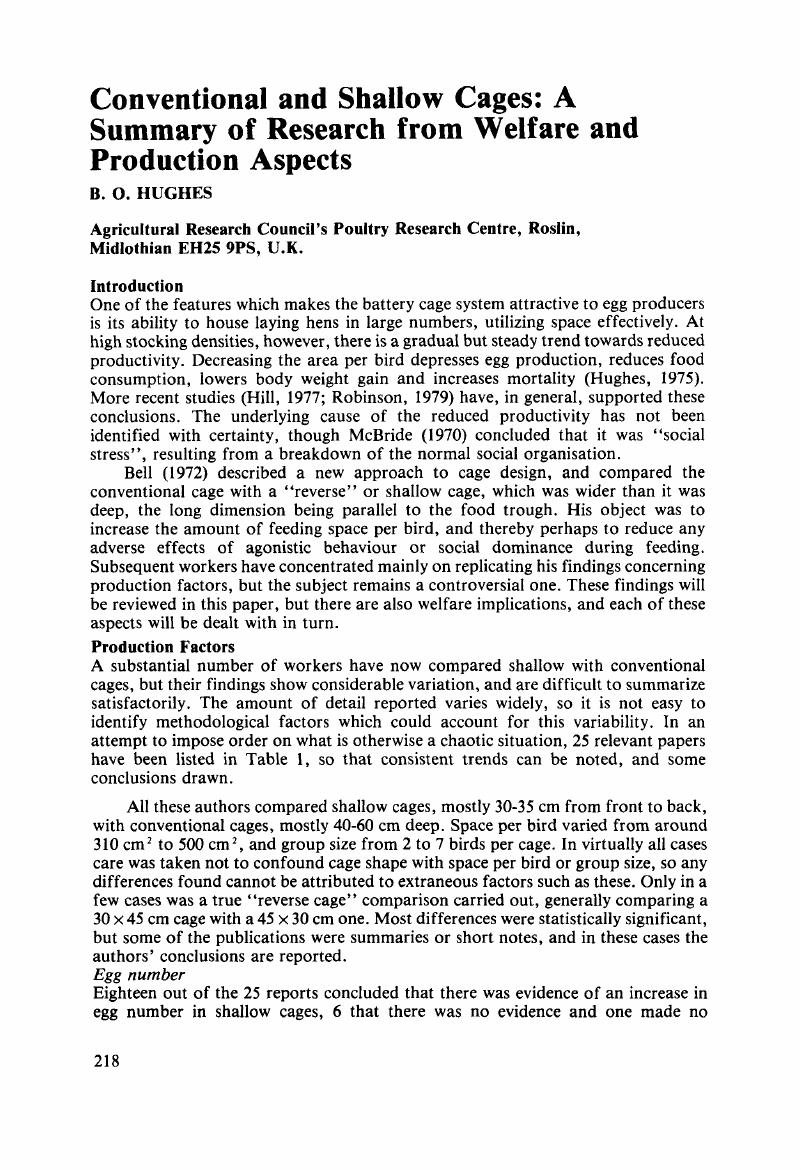Crossref Citations
This article has been cited by the following publications. This list is generated based on data provided by Crossref.
Bessei, W.
1985.
Social Space for Domestic Animals.
p.
71.
Huon, Françoise
Meunier-Salaün, Marie-Christine
and
Faure, Jean-Michel
1986.
Feeder design and available feeding space influence the feeding behaviour of hens.
Applied Animal Behaviour Science,
Vol. 15,
Issue. 1,
p.
65.
DAVAMI, A.
WINELAND, M.J.
JONES, W.T.
ILARDI, R.L.
and
PETERSON, R.A.
1987.
Effects of Population Size, Floor Space, and Feeder Space upon Productive Performance, External Appearance, and Plasma Corticosterone Concentration of Laying Hens.
Poultry Science,
Vol. 66,
Issue. 2,
p.
251.
Mills, Andrew D.
and
Faure, Jean-Michel
1989.
Social Attraction and the Feeding Behaviour of Domestic Hens.
Behavioural Processes,
Vol. 18,
Issue. 1-3,
p.
71.
HAVENSTEIN, G.B.
TOELLE, V.D.
TOWNER, R.H.
and
EMSLEY, ALAN
1989.
Effects of Genetic Strain, Slow Versus Rapid-Feathering Maternal Genotype, and Cage Density on the Performance of Single Comb White Leghorns.
Poultry Science,
Vol. 68,
Issue. 5,
p.
596.
Appleby, M.C.
and
Hughes, B.O.
1991.
Welfare of laying hens in cages and alternative systems: environmental, physical and behavioural aspects.
World's Poultry Science Journal,
Vol. 47,
Issue. 2,
p.
109.
Appleby, M C
1993.
Should Cages for Laying Hens Be Banned or Modified?.
Animal Welfare,
Vol. 2,
Issue. 1,
p.
67.
Appleby, M.C.
1998.
Modification of laying hen cages to improve behavior.
Poultry Science,
Vol. 77,
Issue. 12,
p.
1828.
Appleby, MC
2004.
What causes crowding? Effects of space, facilities and group size on behaviour, with particular reference to furnished cages for hens.
Animal Welfare,
Vol. 13,
Issue. 3,
p.
313.
Albentosa, M.J.
Cooper, J.J.
Luddem, T.
Redgate, S.E.
Elson, H.A.
and
Walker, A.W.
2007.
Evaluation of the effects of cage height and stocking density on the behaviour of laying hens in furnished cages.
British Poultry Science,
Vol. 48,
Issue. 1,
p.
1.
Shimmura, Tsuyoshi
Suzuki, Tomokazu
Azuma, Toshihide
Hirahara, Satoshi
Eguchi, Yusuke
Uetake, Katsuji
and
Tanaka, Toshio
2008.
Form but not frequency of beak use by hens is changed by housing system.
Applied Animal Behaviour Science,
Vol. 115,
Issue. 1-2,
p.
44.
Thogerson, C.M.
Hester, P.Y.
Mench, J.A.
Newberry, R.C.
Pajor, E.A.
and
Garner, J.P.
2009.
The effect of feeder space allocation on behavior of Hy-Line W-36 hens housed in conventional cages.
Poultry Science,
Vol. 88,
Issue. 8,
p.
1544.
Thogerson, C.M.
Hester, P.Y.
Mench, J.A.
Newberry, R.C.
Okura, C.M.
Pajor, E.A.
Talaty, P.N.
and
Garner, J.P.
2009.
The effect of feeder space allocation on productivity and physiology of Hy-Line W-36 hens housed in conventional cages.
Poultry Science,
Vol. 88,
Issue. 9,
p.
1793.
Nahashon, S.N.
Adefope, N.
and
Wright, D.
2011.
Effect of floor density on growth performance of Pearl Grey guinea fowl replacement pullets.
Poultry Science,
Vol. 90,
Issue. 6,
p.
1371.
Lay, D.C.
Fulton, R.M.
Hester, P.Y.
Karcher, D.M.
Kjaer, J.B.
Mench, J.A.
Mullens, B.A.
Newberry, R.C.
Nicol, C.J.
O’Sullivan, N.P.
and
Porter, R.E.
2011.
Hen welfare in different housing systems.
Poultry Science,
Vol. 90,
Issue. 1,
p.
278.
Garner, J.P.
Kiess, A.S.
Mench, J.A.
Newberry, R.C.
and
Hester, P.Y.
2012.
The effect of cage and house design on egg production and egg weight of White Leghorn hens: An epidemiological study.
Poultry Science,
Vol. 91,
Issue. 7,
p.
1522.
Widowski, T.M.
Caston, L.J.
Casey-Trott, T.M.
and
Hunniford, M.E.
2017.
The effect of space allowance and cage size on laying hens housed in furnished cages, Part II: Behavior at the feeder.
Poultry Science,
Vol. 96,
Issue. 11,
p.
3816.
Underwood, Greg
Andrews, Daniel
and
Phung, Tin
2021.
Advances in genetic selection and breeder practice improve commercial layer hen welfare.
Animal Production Science,
Vol. 61,
Issue. 10,
p.
856.
Wang, Yanan
Zhang, Runxiang
Wang, Lisha
Li, Jianhong
Su, Yingying
Li, Xiang
and
Bao, Jun
2022.
Effect of social order, perch, and dust-bath allocation on behavior in laying hens.
Animal Bioscience,
Vol. 35,
Issue. 2,
p.
299.
Nielsen, Søren Saxmose
Alvarez, Julio
Bicout, Dominique Joseph
Calistri, Paolo
Canali, Elisabetta
Drewe, Julian Ashley
Garin‐Bastuji, Bruno
Gonzales Rojas, Jose Luis
Gortázar Schmidt, Christian
Herskin, Mette
Miranda Chueca, Miguel Ángel
Padalino, Barbara
Pasquali, Paolo
Roberts, Helen Clare
Spoolder, Hans
Stahl, Karl
Velarde, Antonio
Viltrop, Arvo
Winckler, Christoph
Estevez, Inmaculada
Guinebretière, Maryse
Rodenburg, Bas
Schrader, Lars
Tiemann, Inga
Van Niekerk, Thea
Ardizzone, Michele
Ashe, Sean
Hempen, Michaela
Mosbach‐Schulz, Olaf
Rojo Gimeno, Cristina
Van der Stede, Yves
Vitali, Marika
and
Michel, Virginie
2023.
Welfare of laying hens on farm.
EFSA Journal,
Vol. 21,
Issue. 2,


